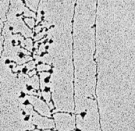« Prev Next »
Every nucleated, diploid cell in the body contains the same DNA, or genome, yet different cells appear committed to different specialized tasks—for example, kidney cells absorb sodium, while pancreatic cells produce insulin. How is this possible? The answer lies in differential use of the genome; in other words, different cells within the body express different portions of their DNA. This process, which begins with the transcription of DNA into RNA, ultimately leads to changes in cell function. Changes in transcription are thus a fundamental means by which cell function is regulated across species. In fact, even single-celled organisms, such as bacteria, regulate gene transcription depending on cues in their environments. Therefore, understanding how transcription is regulated is fundamental to deciphering the mysteries of the genome.
Central to the process of transcription is the complex of proteins known as the RNA polymerases. RNA polymerases have been found in all species, but the number and composition of these proteins vary across taxa. For instance, bacteria contain a single type of RNA polymerase, while eukaryotes (multicellular organisms and yeasts) contain three distinct types. In spite of these differences, there are striking similarities among transcriptional mechanisms. For example, all species require a mechanism by which transcription can be regulated in order to achieve spatial and temporal changes in gene expression. In order to fully understand what this means, it is first necessary to examine the mechanisms of RNA transcription in more detail.
Transcription: An Overview
In all species, transcription begins with the binding of the RNA polymerase complex (or holoenzyme) to a special DNA sequence at the beginning of the gene known as the promoter. Activation of the RNA polymerase complex enables transcription initiation, and this is followed by elongation of the transcript. In turn, transcript elongation leads to clearing of the promoter, and the transcription process can begin yet again. Transcription can thus be regulated at two levels: the promoter level (cis regulation) and the polymerase level (trans regulation). These elements differ among bacteria and eukaryotes.
Transcription in Bacteria
In bacteria, all transcription is performed by a single type of RNA polymerase. This polymerase contains four catalytic subunits and a single regulatory subunit known as sigma (s). Interestingly, several distinct sigma factors have been identified, and each of these oversees transcription of a unique set of genes. Sigma factors are thus discriminatory, as each binds a distinct set of promoter sequences.
A striking example of the specialization of sigma factors for different gene promoters is provided by bacterial sporulation in the species Bacillus subtilis. This bacterium exists in two states: vegetative (growing) and sporulating. Genes involved in spore formation are not normally expressed during vegetative growth. Remarkably, expression of a gene encoding a novel sigma factor turns on the first genes for sporulation. Subsequent expression of different sigma factors then turns on new sets of genes needed later in the sporulation process (Losick & Stragier, 1992). Each of these sigma factors recognizes the promoters of the genes in its group, not those "seen" by other sigma factors. This simple example illustrates how transcription can be regulated in both cis and trans to cause changes in cell function. Therefore, while bacteria accomplish transcription of all genes using a single kind of RNA polymerase, the use of different sigma factor subunits provides an extra level of control.
Transcription in Eukaryotes
Eukaryotic cells are more complex than bacteria in many ways, including in terms of transcription. Specifically, in eukaryotes, transcription is achieved by three different types of RNA polymerase (RNA pol I-III). These polymerases differ in the number and type of subunits they contain, as well as the class of RNAs they transcribe; that is, RNA pol I transcribes ribosomal RNAs (rRNAs), RNA pol II transcribes RNAs that will become messenger RNAs (mRNAs) and also small regulatory RNAs, and RNA pol III transcribes small RNAs such as transfer RNAs (tRNAs). Because RNA pol II transcribes protein-encoding genes, it has been of particular importance to scientists who study the regulation of eukaryotic gene expression, and its function is well understood. For example, researchers know that RNA pol II can bind to a DNA sequence within the promoter of many genes, known as the TATA box, to initiate transcription. Together with other common motifs (short recognition sequences in the DNA), these elements constitute the core promoter. However, changes in RNA pol II affinity and, therefore, gene expression can be influenced by surrounding DNA sequences (enhancers), which in turn recruit transcription factors. While these properties of transcription regulation are very important, they remain an area of active research.
Interestingly, RNA pol II is uniquely sensitive to amatoxins, such as a-amanitin of the extremely toxic Amanita genus of mushrooms (Weiland, 1968), a fact that researchers have been able to exploit for the purposes of polymerase studies - although recreational mushroom hunters should beware! Thus, while eukaryotic transcription is far more complex than bacterial transcription, the main difference between the two types of transcription lies in RNA polymerase.
References and Recommended Reading
Hahn, S. Structure and mechanism of the RNA polymerase II transcription machinery. Nature Structural and Molecular Biology 11, 394–403 (2004) (link to article)
Losick, R., & Stragier, P. Crisscross regulation of cell-type-specific gene expression during development in B. subtilis. Nature 355, 601–604 (1992) doi:10.1038/355601a0 (link to article)
Weiland. T. Poisonous principles of mushrooms of the genus Amanita: Four-carbon amines acting on the central nervous system and cell-destroying cyclic peptides are produced. Science 159, 946–952 (1968).




 Figure 1
Figure 1


























